To calculate your radiant floor heating operational expenses, you'll need to evaluate several factors. Start with your energy source (electricity, gas, etc.) and local energy rates. Factor in your room size, flooring material, and insulation quality. Don't forget to account for your climate and seasonal variations. Your system's energy efficiency rating also plays a vital role. Use these elements to estimate your annual energy consumption and multiply it by your energy rate. Remember, smart thermostat settings can greatly reduce costs. By understanding these components, you'll be better equipped to estimate and optimize your heating expenses.
Understanding Radiant Floor Heating Systems
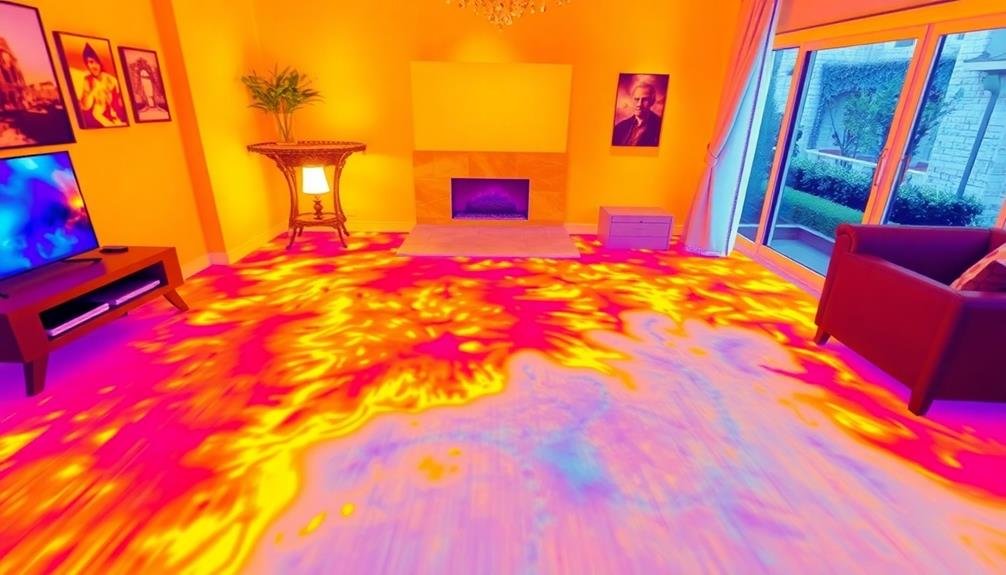
Radiant floor heating systems are an innovative way to warm your home from the ground up. These systems work by installing heating elements beneath your flooring, which radiate heat upwards through the floor surface.
You'll find two main types: electric and hydronic. Electric systems use electric cables or mats, while hydronic systems circulate heated water through pipes.
When you choose radiant floor heating, you're opting for a more energy-efficient and comfortable heating solution. The heat is evenly distributed across the room, eliminating cold spots and drafts.
It's also silent and invisible, preserving your home's aesthetics. You can install radiant heating under various flooring materials, including tile, hardwood, and carpet.
One of the key benefits you'll notice is improved indoor air quality. Unlike forced-air systems, radiant heating doesn't circulate dust or allergens.
It's also highly controllable, allowing you to set different temperatures for various zones in your home. While the initial installation cost may be higher than traditional heating systems, you'll likely see long-term savings on your energy bills due to its efficiency.
Factors Affecting Operational Costs
When considering the operational costs of your radiant floor heating system, you'll need to factor in your chosen energy source.
Whether you opt for electricity, natural gas, or another fuel type will greatly impact your ongoing expenses.
Additionally, the size of the rooms you're heating will play an essential role in determining your system's energy consumption and, consequently, your monthly bills.
Energy Source Considerations
Several key factors influence the operational costs of radiant floor heating, with the energy source being a primary consideration.
You'll need to choose between electricity, natural gas, propane, or oil to power your system. Each option comes with its own set of pros and cons regarding efficiency and cost.
Electricity is widely available and offers easy installation, but it's often the most expensive energy source. Natural gas tends to be more cost-effective in areas where it's readily accessible, providing efficient heating at a lower price point.
Propane can be a viable alternative in regions without natural gas lines, though prices can fluctuate. Oil heating systems are less common but may be an option in some areas.
When selecting your energy source, consider local availability, fuel prices, and long-term cost projections.
You'll also want to factor in the efficiency of your heating system, as high-efficiency units can offset higher fuel costs. Additionally, think about supplementing your radiant floor heating with renewable energy sources like solar panels to potentially reduce operational expenses over time.
Room Size Impact
The size of the room plays an essential role in determining the operational costs of radiant floor heating. Larger rooms require more energy to heat, which directly impacts your expenses. As you calculate your potential costs, consider that the square footage of the space will influence both the initial installation and ongoing operational expenses.
You'll need to account for several factors when evaluating how room size affects your radiant floor heating costs:
- Heat loss: Bigger rooms typically have more external walls and windows, leading to increased heat loss and higher energy consumption.
- Ceiling height: Taller ceilings mean more air volume to heat, potentially raising your operational costs.
- Insulation quality: Well-insulated rooms retain heat better, reducing the system's workload regardless of size.
- Usage patterns: Larger rooms may have different occupancy patterns, affecting how often you'll need to run the heating system.
Keep in mind that while larger rooms generally cost more to heat, the efficiency of radiant floor heating can help mitigate some of these expenses.
You'll experience more consistent temperatures throughout the space, potentially reducing the need for supplemental heating in larger areas.
Energy Source Considerations
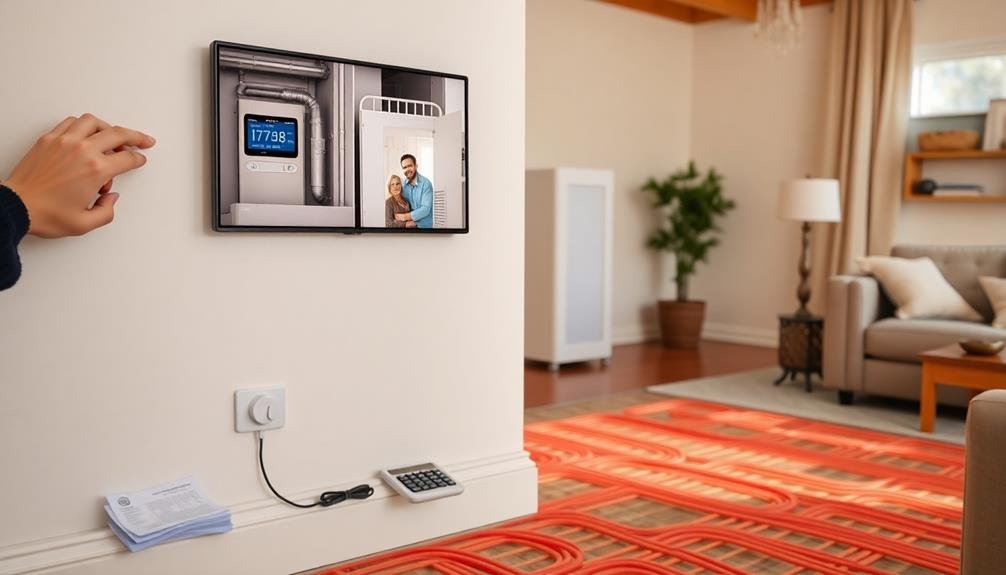
When considering energy sources for your radiant floor heating system, you'll need to weigh the pros and cons of electric and gas options.
You might also explore renewable energy possibilities, such as solar or geothermal, to power your system.
Comparing the initial installation costs, long-term operational expenses, and environmental impact of each energy source will help you make an informed decision.
Electric vs. Gas Options
Choosing between electric and gas options for radiant floor heating can considerably impact your long-term costs and system efficiency.
Electric systems are typically easier to install and have lower upfront costs, but they can be more expensive to operate, especially in areas with high electricity rates.
Gas-powered systems, on the other hand, often have higher initial costs due to the need for a boiler and additional plumbing, but they're generally more cost-effective in the long run.
When deciding between electric and gas options, consider these factors:
- Energy prices in your area
- Your home's existing infrastructure
- Local building codes and regulations
- Environmental impact and personal preferences
Electric systems are ideal for smaller spaces or as supplemental heating, while gas systems are better suited for whole-house heating in colder climates.
You'll need to weigh the installation costs against the ongoing operational expenses to determine which option is best for your situation.
Don't forget to factor in maintenance costs, as gas systems typically require more upkeep than their electric counterparts.
Ultimately, your choice will depend on your specific needs, budget, and local energy prices.
Renewable Energy Possibilities
Exploring renewable energy options for radiant floor heating can greatly reduce your carbon footprint and long-term energy costs.
Solar thermal systems are an excellent choice, using solar collectors to heat water or glycol that circulates through your radiant floor pipes. You'll need to invest in solar panels and a storage tank, but you'll benefit from free, clean energy on sunny days.
Geothermal heat pumps are another eco-friendly option. They harness the earth's stable underground temperature to heat your home efficiently. While installation costs are higher, you'll enjoy lower operating expenses and minimal maintenance over time.
If you have access to a reliable water source, hydroelectric power can be a viable solution. Small-scale hydro systems can generate electricity to power electric radiant floor heating.
For those in windy areas, wind turbines might be worth considering. They can produce electricity to run your radiant floor system, though you'll need to guarantee consistent wind speeds and check local regulations.
Biomass boilers, which burn organic materials like wood pellets or chips, offer a renewable heating option that's particularly suitable for rural areas with abundant biomass resources.
Cost Comparison Analysis
A thorough cost comparison analysis is vital when deciding on the energy source for your radiant floor heating system.
You'll need to take into account various factors, including initial installation costs, ongoing operational expenses, and potential long-term savings. Each energy source has its own set of advantages and drawbacks, so it's important to evaluate them based on your specific needs and circumstances.
When comparing costs, you should:
- Calculate the upfront installation expenses for each energy source option
- Estimate annual operational costs based on local energy prices and system efficiency
- Factor in potential maintenance and repair costs over the system's lifespan
- Take into account any available tax incentives or rebates for specific energy sources
Don't forget to account for future energy price fluctuations and potential changes in your home's heating requirements.
Electric radiant heating might've lower initial costs but higher operational expenses, while hydronic systems powered by natural gas or propane could offer long-term savings despite higher upfront costs.
Solar-powered options may provide significant savings over time but require a substantial initial investment.
Flooring Material Impact
When it comes to radiant floor heating, your choice of flooring material can greatly impact both performance and cost. Some materials conduct heat more efficiently than others, affecting your system's overall energy consumption and operational expenses.
Ceramic and porcelain tiles are excellent conductors, allowing heat to transfer quickly and evenly. They're also durable and cost-effective in the long run.
Natural stone, like marble or slate, performs similarly but may be more expensive upfront. Concrete is another great option, offering high thermal mass and consistent heat distribution.
Hardwood flooring can work with radiant heating, but you'll need to choose engineered wood over solid planks to minimize expansion and contraction.
Laminate flooring is less ideal, as it doesn't conduct heat as efficiently and may act as an insulator.
Carpet isn't recommended for radiant floor heating, as it considerably reduces heat transfer. If you must use carpet, opt for a low-pile variety with a thin underpad.
Room Size and Layout
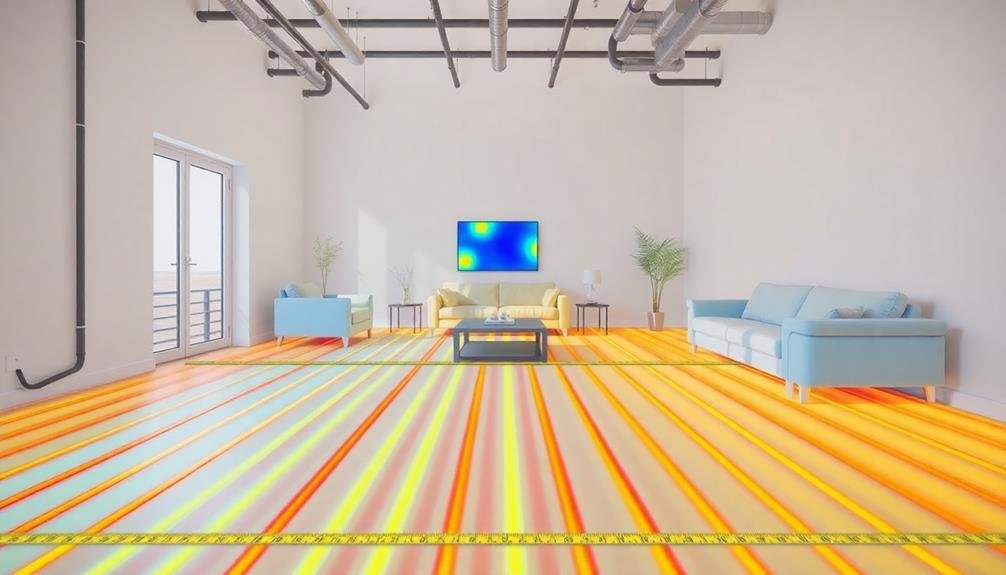
When considering radiant floor heating costs, you'll find that room size and layout play essential roles.
The square footage of your space directly affects the amount of heating material needed and installation time, impacting overall expenses.
Open floor plans often require less tubing and are more efficient to heat, while closed spaces with multiple rooms may need additional zones and controls, potentially increasing costs.
Square Footage Impact
The size and layout of your room greatly influence the cost of radiant floor heating installation. As you'd expect, larger rooms require more materials and labor, leading to higher costs. However, it's not just about square footage; the room's shape and obstacles can also impact expenses.
When calculating the square footage impact on your radiant floor heating costs, consider these factors:
- Total floor area: Measure your room's length and width accurately, then multiply them to get the square footage.
- Heat loss characteristics: Rooms with more exterior walls or large windows may require additional heating capacity.
- Flooring type: Different materials conduct heat differently, affecting the system's efficiency and overall cost.
- Zones and thermostats: Larger spaces may benefit from multiple heating zones, each with its own thermostat.
Keep in mind that while larger rooms generally cost more to heat, they often benefit from economies of scale. The cost per square foot tends to decrease as the total area increases. This is because fixed costs, such as control systems and installation labor, are spread over a larger area.
When planning your radiant floor heating project, consult with a professional to get an accurate estimate based on your specific room size and layout.
Open vs. Closed Spaces
Room size and layout play a crucial role in determining the efficiency and cost of your radiant floor heating system. Open spaces tend to be more cost-effective to heat than closed spaces of the same square footage. This is because heat can circulate more freely in open areas, reducing the need for additional heating elements.
In closed spaces, you'll need to take into account the placement of furniture and fixtures, as they can affect heat distribution. You may require more heating elements to guarantee even warmth throughout the room, potentially increasing your operational costs.
Here's a comparison of open and closed spaces:
| Factor | Open Spaces | Closed Spaces |
|---|---|---|
| Heat Distribution | More even | Less even |
| Energy Efficiency | Higher | Lower |
| Installation Cost | Lower | Higher |
| Furniture Impact | Minimal | Significant |
| Zoning Flexibility | Limited | Greater |
When calculating your radiant floor heating expenses, take into account the layout of your home. If you have an open floor plan, you'll likely see lower operational costs. For closed spaces, you might need to invest in a more complex system with multiple zones to optimize efficiency and comfort. Remember to factor in your lifestyle and how you use different areas of your home when planning your radiant heating system.
Insulation Quality Assessment
Before installing radiant floor heating, evaluating your home's insulation quality is essential. Poor insulation can greatly increase your heating costs, as heat escapes more easily from your living space. To assess your home's insulation, you'll need to examine key areas such as walls, attics, floors, and windows. Look for signs of inadequate insulation, like drafts, cold spots, or high energy bills.
To properly evaluate your insulation quality, follow these steps:
- Conduct a visual inspection of accessible areas, checking for gaps, settling, or damaged insulation.
- Perform a blower door test to measure air leakage and identify problem areas.
- Use an infrared camera to detect temperature differences and locate insulation deficiencies.
- Consult a professional energy auditor for a thorough assessment and recommendations.
Once you've identified any insulation issues, address them before installing radiant floor heating. Upgrading your insulation can dramatically improve your system's efficiency and reduce operational costs.
Consider adding insulation to your walls, attic, and crawl spaces, and seal any air leaks around windows and doors. By ensuring your home is well-insulated, you'll maximize the benefits of your radiant floor heating system and minimize your energy expenses.
Thermostat Settings and Controls
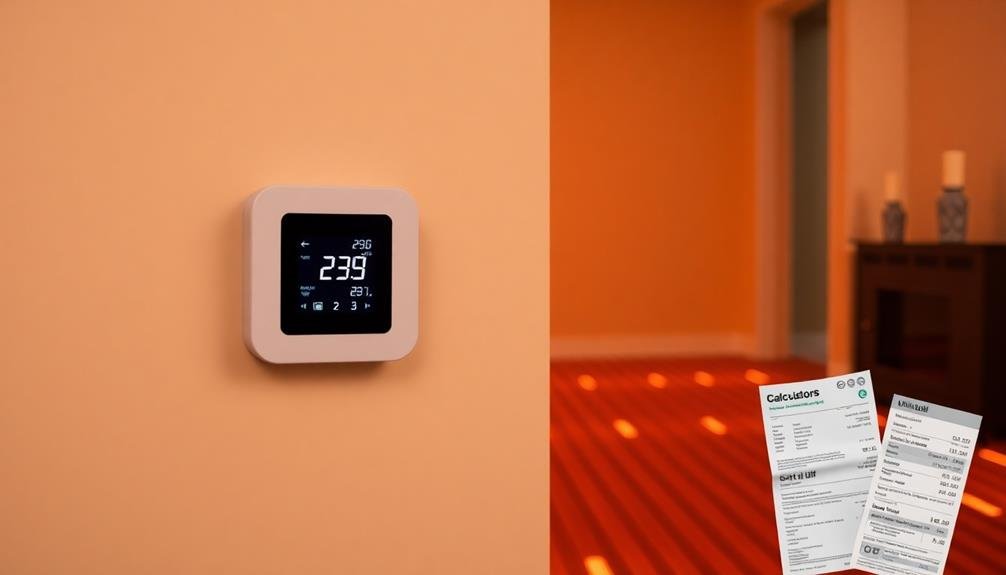
Smart thermostat control is essential for maximizing the efficiency of your radiant floor heating system. By setting your thermostat correctly, you'll guarantee peak comfort while minimizing energy costs. Program your thermostat to lower temperatures when you're asleep or away from home, typically reducing them by 5-8°F. This can lead to significant savings on your heating bills.
Many modern thermostats offer zoning capabilities, allowing you to heat different areas of your home independently. Take advantage of this feature by setting lower temperatures in less-used rooms and maintaining comfort in frequently occupied spaces. Some advanced models even learn your habits and adjust settings automatically.
Consider a Wi-Fi-enabled thermostat that you can control remotely via smartphone. This allows you to adjust settings on the go, guaranteeing your home is warm when you arrive without wasting energy while you're out.
Look for thermostats with humidity sensors, as maintaining proper humidity levels can make your home feel warmer at lower temperatures. Additionally, choose a thermostat with an easy-to-read display and intuitive controls to make adjustments simple and encourage regular use of energy-saving features.
Climate and Seasonal Variations
While radiant floor heating provides consistent warmth throughout the year, climate and seasonal variations can greatly impact its performance and energy consumption.
You'll need to take into account your local weather patterns and how they affect your heating needs. In colder climates, your system will work harder and longer, potentially increasing operational costs. Conversely, milder regions may require less frequent use, resulting in lower expenses.
Seasonal changes also play an important role in your heating requirements. During winter months, you'll likely run your system more often, while spring and fall might demand intermittent use. Summer typically sees minimal to no usage, except in particularly cool areas.
To optimize your radiant floor heating system for various climates and seasons:
- Adjust your thermostat settings according to outdoor temperatures
- Use zoning to heat only occupied areas during milder weather
- Implement a programmable thermostat to account for daily and seasonal variations
- Think about adding insulation to improve efficiency in colder climates
Energy Efficiency Ratings Explained
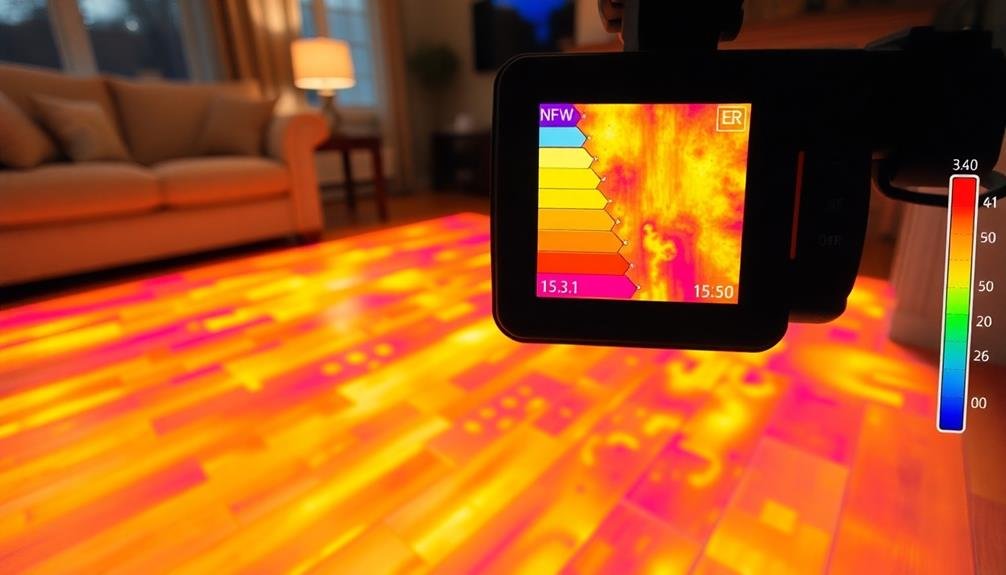
To understand the true cost of radiant floor heating, you'll need to familiarize yourself with energy efficiency ratings. These ratings help you compare different heating systems and estimate their operational costs.
The most common rating for radiant floor heating is the Coefficient of Performance (COP), which measures how efficiently the system converts energy into heat. A higher COP indicates better efficiency. For example, a system with a COP of 4 produces four units of heat for every unit of electricity consumed. Look for systems with COPs above 3.5 for peak efficiency.
Another important rating is the Energy Efficiency Ratio (EER), which measures cooling efficiency but can also apply to heat pumps used in radiant systems.
You'll also encounter AFUE (Annual Fuel Utilization Efficiency) ratings for gas-powered systems. An AFUE of 90% means 90% of the fuel is converted to heat, while 10% is lost. Modern high-efficiency systems can achieve AFUE ratings of 95% or higher.
When comparing systems, consider these ratings alongside your local energy prices to estimate long-term operational costs accurately.
Cost Calculation Formulas
Understanding energy efficiency ratings is just the first step. To accurately calculate your radiant floor heating costs, you'll need to apply specific formulas. These formulas take into account various factors, including your heating system's efficiency, energy rates, and the size of your space.
To calculate your operational expenses, follow these steps:
- Determine your system's wattage per square foot
- Calculate the total wattage for your heated area
- Convert wattage to kilowatt-hours (kWh)
- Multiply kWh by your electricity rate
You'll need to know your system's wattage, which is typically between 10 and 15 watts per square foot. Multiply this by your heated area to get the total wattage.
To convert to kWh, divide the total wattage by 1000 and multiply by the number of hours your system operates daily. Finally, multiply the kWh by your electricity rate.
Keep in mind that these calculations provide an estimate. Actual costs may vary based on factors like insulation, thermostat settings, and local climate.
Long-Term Savings Potential
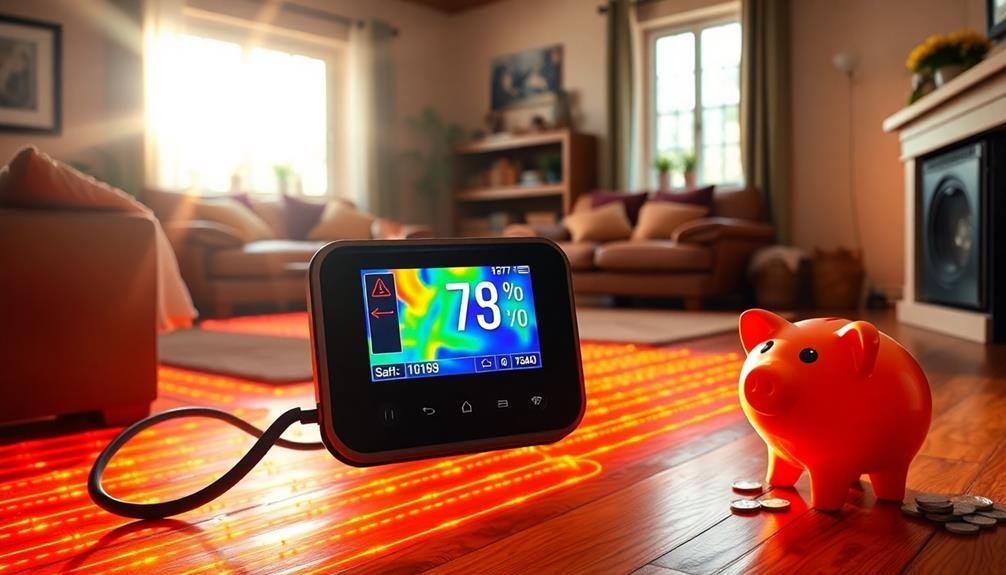
Although radiant floor heating systems may have higher upfront costs, they offer significant long-term savings potential. You'll benefit from increased energy efficiency, as these systems distribute heat evenly and operate at lower temperatures than traditional heating methods. This efficiency can lead to reduced energy bills over time.
Radiant heating also requires less maintenance than forced-air systems, saving you money on repairs and filter replacements. Additionally, you'll enjoy improved indoor air quality, potentially reducing health-related expenses.
Consider these long-term savings factors:
| Savings Factor | Impact on Costs |
|---|---|
| Energy Efficiency | 10-30% lower bills |
| Maintenance | 50-70% less frequent |
| Durability | 20-30 year lifespan |
| Property Value | 2-5% increase |
To maximize your savings, pair your radiant floor heating with a high-efficiency boiler or heat pump. You can also install zone controls to heat only occupied areas, further reducing energy consumption. Remember, while the initial investment may be higher, the long-term benefits often outweigh the costs, making radiant floor heating a smart choice for many homeowners.
Frequently Asked Questions
Can Radiant Floor Heating Be Installed in Existing Homes?
Yes, you can install radiant floor heating in existing homes. You'll need to contemplate your home's structure and flooring type. It's often easier to add during renovations, but retrofit options are available for various floor types.
How Long Does a Typical Radiant Floor Heating System Last?
You can expect your radiant floor heating system to last 20 to 35 years, depending on maintenance and quality. With proper care, it'll serve you well for decades. Regular check-ups can extend its lifespan even further.
Are There Any Health Benefits Associated With Radiant Floor Heating?
You'll enjoy several health benefits with radiant floor heating. It reduces dust circulation, helping allergy sufferers. It also maintains consistent temperatures, preventing cold spots that can lead to discomfort. Plus, it creates a cozy environment that's great for relaxation.
Can Radiant Floor Heating Be Used as the Sole Heating Source?
Yes, you can use radiant floor heating as your sole heating source. It's efficient and provides even warmth throughout your home. However, you'll need to guarantee proper insulation and system sizing to meet your heating needs effectively.
What Maintenance Is Required for Radiant Floor Heating Systems?
You'll find radiant floor heating systems require minimal maintenance. You should have annual inspections, check for leaks, and bleed the system occasionally. It's also wise to keep an eye on your boiler's pressure and performance.
In Summary
You've now got the tools to calculate your radiant floor heating costs accurately. Remember, factors like energy source, flooring material, room size, and climate all play significant roles. Don't forget to take into account energy efficiency ratings and long-term savings potential. By understanding these elements and using the provided formulas, you'll be able to make informed decisions about your heating system and better manage your operational expenses.

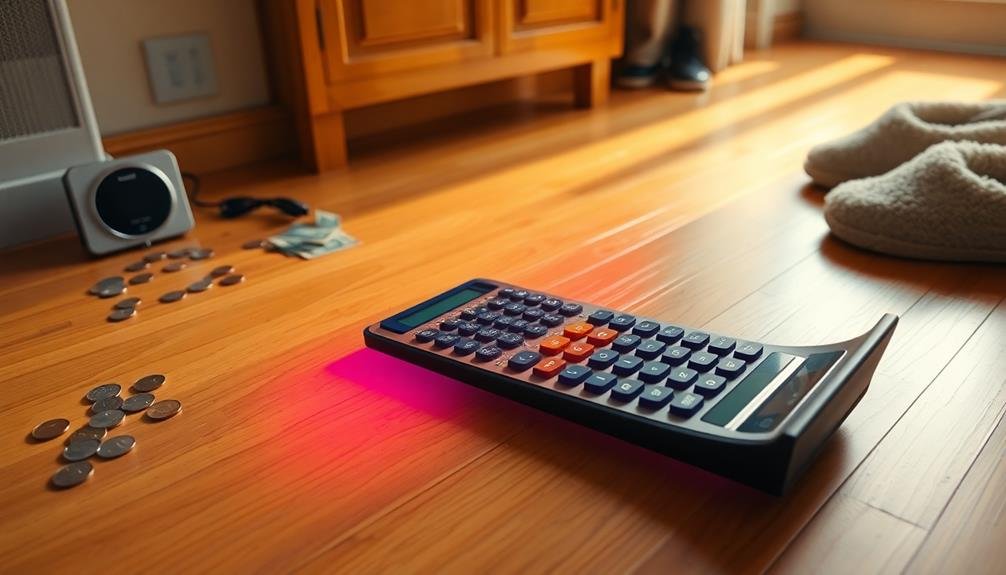



Leave a Reply